Phi Iota Alpha
| Phi Iota Alpha | |
|---|---|
| ΦΙΑ | |
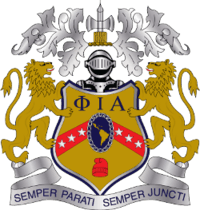 | |
| Founded |
86 years ago |
| Type | Social |
| Scope | National |
| Mission statement |
Phi Iota Alpha Fraternity is a brotherhood dedicated to the promotion and preservation of Latin American Culture. |
| Motto |
Semper Parati Semper Juncti |
| Colors |
Gold Navy Blue Red White |
| Symbol | Lion |
| Flower | Red Carnation |
| Publication | The Phiota! |
| Chapters | 66 chapters, 15 colonies[1] |
| Nickname | Phiota, PhiA |
| Headquarters |
9322 3rd Avenue Suite 412 Brooklyn, New York USA |
| Homepage |
www |
Phi Iota Alpha (ΦΙΑ), established December 26, 1931, is the oldest Latino Fraternity in existence,[2] and works to motivate people, develop leaders, and create innovative ways to unite the Latino community. The organization has roots that stem back to the late 19th century to the first Latin American fraternity, and the first Latin American student organization in the United States.[3] The brotherhood is composed of undergraduate, graduate, and professional men committed towards the empowerment of the Latin American community by providing intensive social and cultural programs and activities geared towards the appreciation, promotion and preservation of Latin American culture.
Membership in Phi Iota Alpha is open to all men regardless of race, creed, colour, or national origin who challenge themselves to develop a strong network for the advancement of Latino people.[4] Phi Iota Alpha's membership includes prominent and accomplished educators, politicians, businessmen, and four former presidents of Latin American countries. Phi Iota Alpha utilizes motifs from the Pan-American revolutionary period and uses images and colours depicting the time of Latin American revolutionaries and thinkers to represent the organization.
History
Origins
The origins of Phi Iota Alpha began at the Rensselaer Polytechnic Institute (RPI), Troy, New York, in 1898.[5] A group of Latin American students organized the Union Hispano Americana (UHA) as a cultural and intellectual secret society based on the ideology of Pan-Americanism.[6] The immediate goals of the UHA was to provide a cultural environment for students of Latin America and Spain. The UHA was the first association of Latin American students ever founded in the United States.[3] The UHA expanded to several colleges and universities in the United States; however, due to the secrecy imposed upon its members, not many records were kept.
The expansion and growth of the UHA was based on compromise and the ultimate need of similar organizations to unify and become more powerful. In the Northeastern Province of the United States, a group of Latin American students decided to organize a cultural and intellectual fraternity; as a result Pi Delta Phi (ΠΔΦ) fraternity was founded at Massachusetts Institute of Technology (MIT) in 1916. Shortly after its foundation, Pi Delta Phi initiated a search to expand to other colleges and universities where they became aware of the existence of other similar organizations.[7]
Consolidation
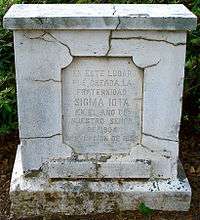
Pi Delta Phi established communications with Phi Lambda Alpha (ΦΛΑ) fraternity, which had been recently founded in 1919, in the Western Province of the United States, at the University of California, Berkeley.[8] After some communication, these two organizations realized the existence of a non-Greek letter secret society, the Union Hispano Americana (UHA). As a result of intensive correspondence and various interviews, the three organizations merged. In their merger agreement, the three organizations adopted the name of Phi Lambda Alpha fraternity, with the distinctive emblem & constitution of Pi Delta Phi, and the goals & motto of the UHA. This new union was formalized on June 11, 1921, in the City of New York.
After ΦΛΑ was organized, other societies joined it: the "Club Latino-Americano" founded in 1919 at Colorado School of Mines; the "Federación Latino-Americana" founded in 1926 at Columbia University which joined in 1928; the "Club Hispania" founded in 1929 of Cornell University which joined in 1931; the "Club Hispano-Americano" founded in 1921 of Tri State College in Angola which joined in 1929 and the Alfa Tenoxtitlan Militant chapter founded in 1929 made up of members of the old ΦΛΑ in Mexico.[9]
Meanwhile, in the Southeastern Province of the United States, another similar organization was under development. In 1904, an organization with similar goals as Phi Lambda Alpha was founded under the name “Sociedad Hispano-Americana” at Louisiana State University. In 1912, recognizing the benefit of the disciplinary background of a Greek system, the society transformed itself into Sigma Iota (ΣΙ) and became the first Latin American–based fraternity in the United States.[10] Between 1912 and 1925, Sigma Iota expanded rapidly in the United States, Central America and Europe. As a result of this, Sigma Iota became the first international Latin American–based fraternity.[11] By 1928, Sigma Iota had lost many of its chapters and therefore sought to stabilize its operations by consolidating its chapters in the United States with a more stationary and well-rooted organization.
Phi Lambda Alpha was seeking to expand throughout the United States and to promote the ideology of Pan Americanism. Sigma Iota Fraternity was in search of revitalizing some of its defunct chapters. Thus both organizations complemented each other and began to work towards the creation of the fraternity now known as Phi Iota Alpha.[7]
Founding
In December 1931 in Troy, New York, delegates from Phi Lambda Alpha and Sigma Iota assembled with the objective of forming a unified fraternity to address the needs of Latin American Students in universities in the United States.
Phi Iota Alpha Fraternity Creed
On December 26, 1931, the first day of a three-day convention, Phi Iota Alpha was born as both groups agreed to the merger.[12] They resolved to unify under one name, one banner, one organization and one ideal. The next day of business was dedicated to preparing the details of revising the constitution, working on the creation of a shield to represent the newly formed national Latino brotherhood. On December 28, by the end of the three-day convention, the majority of the merger was completed. The last step in the merger was the ratification of some of the chapters of Sigma Iota that were not represented at the convention.
The fraternity was incorporated as a national organization on October 28, 1936, under the laws of the State of Louisiana, under the name and title of Phi Iota Alpha Fraternity.[13]
International expansion
After the unification of Sigma Iota and Phi Lambda Alpha, Phi Iota Alpha goal was to expand on the national level and develop a plan for it existing and its potential international possibilities. Phi Iota Alpha sponsored the 1932 convention in New York City with the purpose of forming the Union Latino Americana (ULA)[2][14] with hopes of expanding its ideals internationally. The ULA was a Pan American governing body of Latino fraternities which provides the framework for the implementation of Pan-American ideology. The ULA organized Latin America into 22 zones with each of the 21 Latin American countries constituting a zone, and Phi Iota Alpha representing the 22nd zone in the United States. By 1937, the ULA had several well-established and functional zones including:
- ΦΙΑ – Phi Iota Alpha in the D.C. and the states of the USA
- ΦΚΑ – Phi Kappa Alpha in
 Cuba[15]
Cuba[15] - ΦΣΑ – Phi Sigma Alpha in
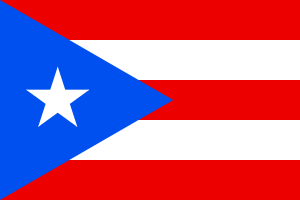 Puerto Rico (U.S.)
Puerto Rico (U.S.) - ΦΤΑ – Phi Tau Alpha in
 Mexico
Mexico
In September 1938, the Phi Sigma Alpha zone decided to separate from the ULA and eventually, to form Phi Sigma Alpha Fraternity of Puerto Rico which exists to this day.[16] Twelve years later, Phi Tau Alpha Fraternity established itself, in Mexico, at the Juarez Institute.
History: 1939–1983
The outbreak of World War II greatly hindered the growth Phi Iota Alpha in the United States. After the war the Fraternity drafted and implemented a new expansion strategy. As a result, the post war period saw positive internal growth for the Fraternity. In the early 1950s, Phi Iota Alpha eradicated any remnant of its political agenda. With only a few chapters, the Fraternity continued to pursue its mission. The Fraternity was again incorporated as a national organization on January 9, 1953, when the Secretary of State of New York accepted the incorporation of Phi Iota Alpha Fraternity.[17]
The 1960s were very challenging years for Phi Iota Alpha. The effects of the Vietnam War and the '60s counter-culture created an anti-institutional atmosphere amongst many college students. In addition, this drastically reduced the enrollment of Latin American students in American universities. This in turn hindered potential membership to the organization. As a result, by 1968, after many years of struggle, the only active undergraduate chapters were at LSU, and at RPI. The chapter at RPI became inactive in 1973 with the graduation of its Secretary General. The Secretary General took with him the chapter's official fraternity documents. By 1979, the last active brother from the chapter at LSU graduated, thereby marking the closing of the undergraduate chapter at LSU.
From 1979 to 1983, the Fraternity witnessed a period of inactivity only at the undergraduate level. Some efforts were made to re-establish Phi Iota Alpha at the undergraduate level, but these efforts were not successful. Throughout this period, brothers continued to maintain communication, and continued to accomplish the mission of the organization. The history, ideals and goals of the Fraternity never diminished; they simply did not have active undergraduate members to cultivate them. Phi Iota Alpha continued to exist with the many Alumni members and Alumni chapters as they continued to develop their professional lives mostly in Latin American countries and in the United States.[7]
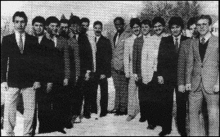
History: 1984–2000
In 1984, a group of young men at RPI, set upon learning about the fraternity that once existed on their campus, re-established Phi Iota Alpha. After the re-emergence of the Fraternity, the last Secretary General instituted the members of the RPI chapter as the Alpha Chapter of Phi Iota Alpha. In the 1980s the Fraternity dedicated its efforts to rebuilding the organizational infrastructure and to expand to several universities in New York State. By 2000, Phi Iota Alpha had chartered chapters across the United States; which include the re-establishments of former Sigma Iota (ΣΙ) fraternity chapter Syracuse University and former Phi Lambda Alpha (ΦΛΑ) fraternity chapter Columbia University.[7]
75th anniversary
Phi Iota Alpha declared 2006 and 2007 to celebrate the Diamond Jubilee. Preparations consisted of nationwide activities and events, including the commissioning of intellectual and scholarly works, presentation of exhibits, lectures, artwork and musical expositions, the production of video presentations. The 75th Anniversary Celebration was launched with a pilgrimage to Rensselaer Polytechnic Institute on October 13, 2006, and culminated with the Demisesquicentennial Anniversary Convention on the weekend of July 27 to July 29, 2007, in New York City.[18]
Fraternal entities
National programs
Phi Iota Alpha asserts that through community outreach initiatives, the fraternity supplies voice and vision to the struggle of Latino and Hispanic Americans in the United States and Latin America. The fraternity provides for charitable endeavors through its Foundations, providing academic scholarships and support for community development projects.
UNICEF

United Nations Children's Fund (or UNICEF) was created by the United Nations General Assembly, to provide emergency food and healthcare to children in countries that had been devastated by World War II. UNICEF provides long-term humanitarian and developmental assistance to children and mothers in developing countries.
Affiliations
The fraternity maintains dual membership in the National Association of Latino Fraternal Organizations (NALFO) and the North-American Interfraternity Conference (NIC).
NALFO is composed of 19 Latino Greek-letter sororities and fraternities, of which Phi Iota Alpha is the oldest member. The association promotes and fosters positive interfraternal relations, communication, and development of all Latino fraternal organizations through mutual respect, leadership, honesty, professionalism and education.[19]
The NIC serves to advocate the needs of its member fraternities through enrichment of the fraternity experience; advancement and growth of the fraternity community; and enhancement of the educational mission of the host institutions.[20]
Phi Iota Alpha is also a member of the NIC Latino Fraternal Caucus. One of the only four Latino fraternities that are part of the NIC.[21] Prior to joining NALFO, Phi Iota Alpha was a member of the Concilio Nacional de Hermandades Latinas.
NALFO awards
As a member of NALFO, Phi Iota Alpha Fraternity, Inc. has earned the following awards:
- Fraternity of the Year
- National Philanthropic Organization of the Year
- Organizational Leadership Excellence of the Year
- Campus Leadership Excellence of the Year
- Philanthropic Excellence Undergraduate Chapter of the Year
- Undergraduate Excellence of the Year
- Professional of the Year
- Rising Professional of the Year
Phi Iota Alpha Fraternity, Inc. was recognized as the National Fraternity of the Year in 2011, 2012 and 2016 by the National Association of Latino Fraternal Organizations (NALFO).
Fraternal ideology
| This article is a part of a series on Phi Iota Alpha Fraternity | |
Chapters | |
| See also: Fraternities and Sororities Wikiproject | |
Beliefs
Members of Phi Iota Alpha share a lifelong commitment to Latin American culture. Involves intellectual development, cultural consciousness, personal growth, personal achievement and social awareness. Members of Phi Iota Alpha believe that the Latin American community in the United States and in the Latin American countries are in need of new sources of intellectual capital to identify, address and solve the difficult challenges they face. Therefore, the organization is dedicated to developing in its members an awareness of the common values and traditions of the nations of Latin America and to preparing them to become active participants in the process of advancing the social and economic conditions of all Latin Americans.
The fraternity instills in its members a global Latino perspective. This is an orientation that transcends the existing national boundaries that have separated Latin America. It builds on the spirit and traditions of Pan-Americanism, and supports and promotes actions leading to an eventual unification of all the countries of Latin America.[22]
Mission
- Promotion of personal, community, and Pan-American development through the ideals of Simón Bolívar and José Martí as well as other Pan-American intellectuals and their philosophies;
- Creation of a Latin American consciousness,
- Intensification of education with a Latin American character;
- Economic and social mobilization of Latin American communities globally;
Fraternal Vision of Phi Iota Alpha Fraternity
- Intensification of contact between Pan-American Countries with the intention of forming a unified network of professional and economic contacts in order to ultimately achieve the unification of Latin America;
- Conservation of the integrity of the Latin American character.
- Rejection of war and violence as a means to achieving unification.[22]
Pillars
The organization has five pillars, respected historical figures from Latin America:
 Don Simón Bolívar
Don Simón Bolívar.jpg)

 Don Benito Juárez
Don Benito Juárez Don José Martí
Don José Martí
Symbolism
Pan-American symbolism

Phi Iota Alpha chose to use Pan-American symbolism to be more representative of the goals and ideals of the organization. Phi Iota Alpha utilizes motifs from the Pan-American revolutionary period and uses images and colours depicting the time of Latin American revolutionaries and thinkers to represent the organization. This is in contrast to most other Latino fraternities that traditionally echo themes from the Pre-Columbian period of Latin American history. Phi Iota Alpha's constant reference to Pan-American ideals in hymns and poems are further examples of Phi Iota Alpha's mission to imbue with a Pan-American cultural perspective.
Colours
The Colours of the fraternity in Spanish Heraldry are oro, azur, gules and plata.
The Colours of the fraternity in English Heraldry are or, azure, gules and argent.
The Colours of the fraternity in Spanish are oro, azul marino, rojo and blanco.
The Colours of the fraternity in English are gold, navy blue, red and white.[23]
Badge
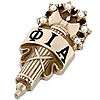
The badge is the most prominent symbol of membership. The Official Badge of the Fraternity is a gold pin in the shape of a Roman fasces topped with a double-edged ax and crowned in the superior of the fasces of six stars, each star with an argent pearl at its centre. The fasces are held together by two ropes in gold that tie the fasces at the top and at the bottom and in which the middle is tied in the form of an x-shaped cross. In the middle of the fasces, above the ropes lies an argent riband in which engraved to it are the Greek Letters Phi Iota Alpha. The badge dies at the bottom with a golden sphere that culminates the fasces.[23]
Flag

The official flag consists of three bands in or, azure, and gules of equal height. The Greek letters ΦΙΑ in Or are located on the azure field at the center outlined with argent. The chapter letter is carried on the Gules band sinister in argent.[23] The flag is modeled after the flag of Simón Bolívar's Republic of Gran Colombia. The short-lived republic that consisted of present-day Colombia, Venezuela, Ecuador, and Panama.
Coat of arms
The Fraternity insignia, coat of arms or crest, consists of a blazon composed of an or (gold) shield, gules chevron lowered a third charged with six argent stars, three dexter, three sinister. At the fess point, under an oval azure field, the Latin American Map in Or, surrounded by a steel chain made of twenty-one links. The Greek letters Phi Iota Alpha in azure in dexter, fess point and sinister of the chief, occupying a third part of the canton. At the base, a Phrygian Cap in gules facing dexter. The principal bordure is double in azure and argent, respectively. The shield is crowned with a frontal steel helm with nine bars and adorned with argent lambrequins falling at dexter and sinister. The crest is formed by a Roman fasces in or, in vertical position, and a double-edged ax. A pair of lions rampant with sanguine tongues supports the shield. The riband for the motto at the Lions' feet, in argent, with azure letters states: Semper Parati Semper Juncti.[23]
Membership
Phi Iota Alpha's membership is predominantly Latino and Hispanic American in composition. Members come from the United States, the Caribbean, Latin America, Africa, Asia, and Europe. As Phi Iota Alpha expanded, the ranks of membership grew to include a plethora of prominent and accomplished, educators, politicians, businessmen, and four former presidents of Latin American countries.
Notable members
Politics
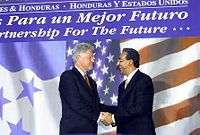

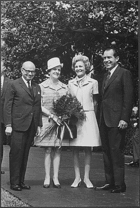
Former President of Colombia with former President Richard Nixon
- Miguel Hernandez Agosto – former President of the Popular Democratic Party of Puerto Rico
- Emilio Bacardi – former mayor of Santiago, Cuba and son of Bacardi Founder Facundo Bacardi
- Eric Arturo Delvalle[25] – former President of Panama
- Carlos Roberto Flores[26][27] – former President of Honduras
- Enrique Oltuski[28] – Deputy Minister of Communication for former President Manuel Urrutia Lleo of Cuba; author of Vida Clandestina: My Life in the Cuban Revolution[29]
- Mariano Ospina Pérez[30] – former President of Colombia
- Carlos Lleras Restrepo[30] – former President of Colombia
- Alfonso Robelo Callejas[31] – Founder of the Democratic Movement Party of Nicaragua
- Manny De Los Santos – City of New York 72nd Assembly Male District Leader of Inwood/Marble Hill
Diplomacy
- Eduardo Vallarino Arjona – former Ambassador of Panama to the United Nations
- Guillermo Chapman Jr.[32] – Latin American Shadow Financial Regulatory Committee member; Chairman and CEO of INDESA; current Board of Director of the Panama Canal Authority
- Harry A. Diaz – current Ambassador of Panama to the Russian Federation; Community of Independent States
- Osvaldo Velasquez – former council member of International Physicians for the Prevention of Nuclear War, an organization that won the Nobel Peace Prize in 1985[33]
Business
- Luis Bacardi[34] – of the Bacardi family
- Manuel J. Cutillas[31] – former Chairman of the Board and CEO of Bacardi Ltd.
- Manuel Gaetan[35] – former President Emeritus of the Bobbin Group of Miller Freeman, Inc.
- Orlando A. Gutierrez[36] – former President of the Society of Hispanic Professional Engineers
Education
- Ernesto E. Blanco, P.E. – Professor of Mechanical Engineering Department, Massachusetts Institute of Technology
- Roberto Antonio Gordillo – President of the National Association of Librarians and Archivists of Mexico; Director of the National School Librarians and Archivists of Mexico; Deputy Director of Libraries and Archives of the Ministry of Finance and Public Credit of Mexico
- Juan R. Guardia, PhD – Director of Multicultural Affairs and Adjunct Faculty, Department of Educational Leadership and Policy Studies, Florida State University
- Tomas L. Lopez-Gottardi – Professor of Architectural Design, Urban Design, Drawing and Theory/History University of Miami - School of Architecture
- Christopher MacDonald-Dennis, Ed.D. – Dean of Multicultural Life, Macalester College
- José Luis Solache – President of the Lynwood, California School District
- Osvaldo Velasquez – Professor of Medicine of The Universidad de Panamá
Media
- Jorge Avellán[37] – reporter for MyTV20 Detroit WMYD, Detroit
- Omar Cabrera[38] – sports reporter for Telemundo WNEU and Boston Latino TV, Boston
- Jose Sanchez – author of From Hell to Hell[39]
Medicine
- Dr. Rudolph Matas[40] – "father of modern vascular surgery"
Fraternal dates of celebration
- April 14 (Pan American Day)
- September 15 – October 15 (National Hispanic Heritage Month)
- October 12 (Day of the Race)
- December 26 (Founding Day Anniversary and Day of the illuminated Latin Americans)
See also
References
- ↑ "Chapters & Colonies - Phi Iota Alpha".
- 1 2 Baily, Harold J. (1949). Baird's Manual of American College Fraternities. Menasha, Wisconsin: Banta Publishing Company. p. 315. OCLC 1353909.
- 1 2 Ricketts, Palmer C. (1934). A History of Rensselaer Polytechnic Institute, 1824–1934. New York, New York: Wiley Publishing Company.
- ↑ "Phi Iota Alpha Latino Fraternity::: Membership". Archived from the original on June 30, 2007. Retrieved March 29, 2007.
- ↑ Fine, Elizabeth C (2003). Soulstepping: African American step shows. Urbana, Illinois: University of Illinois Press. p. 111. ISBN 0-252-02475-3.
- ↑ "Universities and World Affairs". Carnegie Endowment for International Peace. 1952. ISSN 0502-6393.
- 1 2 3 4 "Phi Iota Alpha Latino Fraternity::: Fraternal History". Archived from the original on July 3, 2007. Retrieved December 4, 2006.
- ↑ University of California Berkeley Blue & Gold Yearbook. Berkeley, California: University of California Berkeley. 1922. p. 600.
- ↑ "Sigma History" (in Spanish). Archived from the original on July 23, 2011. Retrieved May 1, 2008.
- ↑ Brown, Tamara L.; Gregory S. Parks; Clarenda M. Phillips (2005). African American Fraternities And Sororities: The Legacy And The Vision. Lexington, Kentucky: University Press of Kentucky. p. 59. ISBN 0-8131-2344-5.
- ↑ Anson, Jack L.; Robert F. Marchesani Jr (1991). Baird's Manual of American College Fraternities. Menasha, Wisconsin: Banta Publishing Company. VIII-22. ISBN 0-9637159-0-9.
- ↑ Staff writer (January 8, 1932). "Phi Lambda Alpha and Sigma Iota To Unite" (PDF). The Tech. MIT. p. 1. Retrieved December 3, 2005.
- ↑ "Louisiana Office of the Secretary of State". sos.louisiana.gov. Archived from the original on August 5, 2012. Retrieved December 3, 2006.
- ↑ Johnson, Clyde Sanfred (1972). Fraternities in our colleges. New York, New York: National Interfraternity Foundation. pp. 42–43.
- ↑ Baird, William Raimond (1940). Baird's Manual of American College Fraternities. G. Banta Pub. Co. p. 260.
- ↑ "Fi Sigma Alfa" (in Spanish). Retrieved December 4, 2006.
- ↑ "New York Office of the Secretary of State". dos.state.ny.us. Retrieved December 3, 2006.
- ↑ Crowley, Cathleen F (October 16, 2006). "Latino solidarity marks 75 years". Albany Times Union. Capital Newspapers. Retrieved December 3, 2005.
- ↑ "National Association of Latino Fraternal Organizations". NALFO. Retrieved December 2, 2006.
- ↑ "North-American Interfraternity Conference". NIC. Retrieved December 1, 2006.
- ↑ "NALFO: Uniting Latino Fraternities and Sororities". Association of Fraternity Advisors. Retrieved December 4, 2007.
- 1 2 "Phi Iota Alpha Latino Fraternity::: Who We Are". Archived from the original on May 21, 2007. Retrieved December 4, 2006.
- 1 2 3 4 5 Phi Iota Alpha Fraternity Bylaws. 2006. pp. 28–30.
- ↑ "José de San Martín – Wikiquote". Wikimedia Foundation. Retrieved December 4, 2006.
- ↑ Gumbo Yearbook. Baton Rouge, Louisiana: Louisiana State University. 1955. LD3118 .G8 1954.
- ↑ Byers, Paula Kay; Suzanne Michele Bourgoin (1998). Encyclopedia of World Biography. Farmington Hills, Michigan: Thomson Gale Publishing Company. ISBN 0-7876-2221-4.
- ↑ Staff writer (December 9, 1997). "New Honduras chief an LSU grad". The Advocate. Capital City Press. p. 14-A.
- ↑ University of Miami Ibis Yearbook. Miami, Florida: University of Miami. 1955.
- ↑ Oltuski, Enrique (2000). Vida Clandestina: My Life in the Cuban Revolution. New York, New York: Wiley Publishing Company. ISBN 0-7879-6169-8.
- 1 2 "Presidencia de la Republica de Colombia". Bogota- Casa de Narino. Archived from the original on June 22, 2009. Retrieved November 16, 2009.
- 1 2 Rensselaer Polytechnic Institute Transit Yearbook. Troy, New York: Rensselaer Polytechnic Institute. 1960.
- ↑ "Latin American Shadow Financial Regulatory Committee". CLAAF. Archived from the original on May 17, 2008. Retrieved November 16, 2009.
- ↑ "The Nobel Peace Prize 1985". Nobel Foundation. Retrieved November 16, 2009.
- ↑ Rensselaer Polytechnic Institute Transit Yearbook. Troy, New York: Rensselaer Polytechnic Institute. 1917.
- ↑ Rensselaer Polytechnic Institute Transit Yearbook. Troy, New York: Rensselaer Polytechnic Institute. 1956.
- ↑ Adam, Michelle (February 26, 1999). "Greeks Empowering Latino". Latino Outlook in Higher Education. pp. 17–19.
- ↑ "My TV20 Detroit". My TV20 Detroit. Archived from the original on January 5, 2010. Retrieved November 16, 2009.
- ↑ "BLTV: Omar Cabrera". BLTV. Archived from the original on November 6, 2009. Retrieved November 16, 2009.
- ↑ Sanchez, Jose (2000). From Hell to Hell. PublishAmerica. p. 328. ISBN 1-58851-806-X.
- ↑ "Orleans Draws Latin Americans Seeking Culture". New Orleans, Louisiana: The New Orleans Times-Picayune. January 3, 1931. p. 20. Check date values in:
|access-date=(help);
